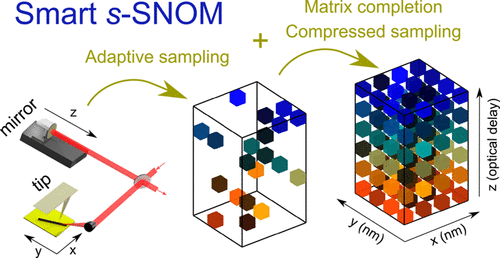当前位置:
X-MOL 学术
›
ACS Photonics
›
论文详情
Our official English website, www.x-mol.net, welcomes your feedback! (Note: you will need to create a separate account there.)
Smart Scattering Scanning Near-Field Optical Microscopy
ACS Photonics ( IF 7 ) Pub Date : 2020-11-12 , DOI: 10.1021/acsphotonics.0c00553 Simon Labouesse 1 , Samuel C. Johnson 2 , Hans A. Bechtel 3 , Markus B. Raschke 2 , Rafael Piestun 1
ACS Photonics ( IF 7 ) Pub Date : 2020-11-12 , DOI: 10.1021/acsphotonics.0c00553 Simon Labouesse 1 , Samuel C. Johnson 2 , Hans A. Bechtel 3 , Markus B. Raschke 2 , Rafael Piestun 1
Affiliation

|
Scattering scanning near-field optical microscopy (s-SNOM) provides spectroscopic imaging from molecular to quantum materials with few nanometer deep subdiffraction limited spatial resolution. However, in its conventional implementation s-SNOM is slow to effectively acquire a series of spatio-spectral images, especially with large fields of view. This problem is further exacerbated for weak resonance contrast or when using light sources with limited spectral irradiance. Indeed, the generally limited signal-to-noise ratio prevents sampling a weak signal at the Nyquist sampling rate. Here, we demonstrate how acquisition time and sampling rate can be significantly reduced by using compressed sampling, matrix completion, and adaptive random sampling, while maintaining or even enhancing the physical or chemical image content. We use fully sampled real data sets of molecular, biological, and quantum materials as ground-truth physical data and show how deep under-sampling with a corresponding reduction of acquisition time by 1 order of magnitude or more retains the core s-SNOM image information. We demonstrate that a sampling rate of up to 6× smaller than the Nyquist criterion can be applied, which would provide a 30-fold reduction in the data required under typical experimental conditions. Our smart s-SNOM approach is generally applicable and provides systematic full spatio-spectral s-SNOM imaging with a large field of view at high spectral resolution and reduced acquisition time.
中文翻译:

智能散射扫描近场光学显微镜
散射扫描近场光学显微镜(s -SNOM)提供了从分子到量子材料的光谱成像,几乎没有纳米级的深亚衍射限制了空间分辨率。然而,在其常规执行s ^-SNOM很难有效地获取一系列时空光谱图像,尤其是在大视野范围内。对于弱的共振对比度或使用光谱辐照度有限的光源时,此问题会进一步恶化。实际上,通常受限的信噪比阻止了以奈奎斯特采样率采样弱信号。在这里,我们演示了如何通过使用压缩采样,矩阵完成和自适应随机采样来显着减少采集时间和采样率,同时保持甚至增强物理或化学图像内容。我们使用分子,生物和量子材料的完全采样的真实数据集作为真实的物理数据,并显示深度采样不足并相应地将采集时间减少了一个数量级或更多的保留了核心s -SNOM图像信息。我们证明可以应用比Nyquist标准小的6倍的采样率,这将使典型实验条件下所需的数据减少30倍。我们的智能s -SNOM方法通常适用,并提供系统的全空间光谱s -SNOM成像,并具有高视野,高光谱分辨率和缩短的采集时间。
更新日期:2020-12-16
中文翻译:

智能散射扫描近场光学显微镜
散射扫描近场光学显微镜(s -SNOM)提供了从分子到量子材料的光谱成像,几乎没有纳米级的深亚衍射限制了空间分辨率。然而,在其常规执行s ^-SNOM很难有效地获取一系列时空光谱图像,尤其是在大视野范围内。对于弱的共振对比度或使用光谱辐照度有限的光源时,此问题会进一步恶化。实际上,通常受限的信噪比阻止了以奈奎斯特采样率采样弱信号。在这里,我们演示了如何通过使用压缩采样,矩阵完成和自适应随机采样来显着减少采集时间和采样率,同时保持甚至增强物理或化学图像内容。我们使用分子,生物和量子材料的完全采样的真实数据集作为真实的物理数据,并显示深度采样不足并相应地将采集时间减少了一个数量级或更多的保留了核心s -SNOM图像信息。我们证明可以应用比Nyquist标准小的6倍的采样率,这将使典型实验条件下所需的数据减少30倍。我们的智能s -SNOM方法通常适用,并提供系统的全空间光谱s -SNOM成像,并具有高视野,高光谱分辨率和缩短的采集时间。

























 京公网安备 11010802027423号
京公网安备 11010802027423号